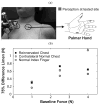Examination of force discrimination in human upper limb amputees with reinnervated limb sensation following peripheral nerve transfer
- PMID: 19775983
- PMCID: PMC3025706
- DOI: 10.1109/TNSRE.2009.2032640
Examination of force discrimination in human upper limb amputees with reinnervated limb sensation following peripheral nerve transfer
Abstract
Artificial limbs allow amputees to manipulate objects, but the loss of a limb severs the sensory link between a subject and objects they touch. A novel surgical technique we term targeted reinnervation (TR) allows severed cutaneous nerves to reinnervate skin on a different portion of the body. This technique provides a physiologically appropriate portal to the sensory pathways of the missing limb through the reinnervated skin. This study quantified the ability of three amputee subjects who had undergone TR surgery on the chest (two subjects) and upper arm (one subject) to discriminate changes in graded force on their reinnervated skin over a range of 1-4 N using a stochastic staircase approach. These values were compared to those from sites on their intact contralateral skin and index fingers, and from the chests and index fingers of a control population (n = 10) . Weber's ratio (WR) was used to examine the subjects' abilities to discriminate between a baseline force and subsequent forces of different magnitudes. WRs of 0.22, 0.25, and 0.12 were measured on the reinnervated skin of the three TR subjects, whereas WRs of 0.25, 0.23, and 0.12 were measured on their contralateral skin. TR subjects did not have substantially different WRs on their reinnervated versus their contralateral normal side and did not appear to exhibit a trend towards impaired sensation. No significant difference was found between the WR of the chest and index finger of the control subjects, which ranged between 0.09 and 0.21. WR of reinnervated skin for TR subjects were within the 95% confidence interval of the control group. These data suggest that subjects with targeted reinnervation have unimpaired ability to discriminate gradations in force.
Figures




Similar articles
-
Vibrotactile detection thresholds for chest skin of amputees following targeted reinnervation surgery.Brain Res. 2009 Jan 28;1251:121-9. doi: 10.1016/j.brainres.2008.11.039. Epub 2008 Nov 21. Brain Res. 2009. PMID: 19059226
-
Sensory capacity of reinnervated skin after redirection of amputated upper limb nerves to the chest.Brain. 2009 Jun;132(Pt 6):1441-8. doi: 10.1093/brain/awp082. Epub 2009 Apr 15. Brain. 2009. PMID: 19369486 Free PMC article.
-
Redirection of cutaneous sensation from the hand to the chest skin of human amputees with targeted reinnervation.Proc Natl Acad Sci U S A. 2007 Dec 11;104(50):20061-6. doi: 10.1073/pnas.0706525104. Epub 2007 Nov 28. Proc Natl Acad Sci U S A. 2007. PMID: 18048339 Free PMC article.
-
Sensory feedback in upper limb prosthetics.Expert Rev Med Devices. 2013 Jan;10(1):45-54. doi: 10.1586/erd.12.68. Expert Rev Med Devices. 2013. PMID: 23278223 Review.
-
Surgical and technological advances in the management of upper limb amputees.Bone Joint J. 2021 Mar;103-B(3):430-439. doi: 10.1302/0301-620X.103B3.BJJ-2020-1184.R1. Bone Joint J. 2021. PMID: 33641410 Review.
Cited by
-
Automatic hand phantom map generation and detection using decomposition support vector machines.Biomed Eng Online. 2018 Jun 11;17(1):74. doi: 10.1186/s12938-018-0502-8. Biomed Eng Online. 2018. PMID: 29890988 Free PMC article.
-
Leveraging LSTM, tactile sensors, and haptic feedback to augment prosthetic control via grasp type prediction and grasp type feedback.Sci Rep. 2025 Aug 14;15(1):29781. doi: 10.1038/s41598-025-92651-z. Sci Rep. 2025. PMID: 40804118 Free PMC article.
-
Beyond Amputation: Functional Restoration after Upper-Extremity Limb Loss.J Hand Surg Glob Online. 2025 Feb 7;7(2):368-375. doi: 10.1016/j.jhsg.2025.01.008. eCollection 2025 Mar. J Hand Surg Glob Online. 2025. PMID: 40182885 Free PMC article.
-
Amputation with median nerve redirection (targeted reinnervation) reactivates forepaw barrel subfield in rats.J Neurosci. 2010 Nov 24;30(47):16008-14. doi: 10.1523/JNEUROSCI.4044-10.2010. J Neurosci. 2010. PMID: 21106839 Free PMC article.
-
Regenerative Engineering and Bionic Limbs.Rare Metals. 2015 Mar 1;34(3):143-155. doi: 10.1007/s12598-015-0446-0. Rare Metals. 2015. PMID: 25983525 Free PMC article.
References
-
- Kuiken TA, Dumanian GA, Lipschutz RD, Miller LA, Stubblefield KA. The use of targeted muscle reinnervation for improved myoelectric prosthesis control in a bilateral shoulder disarticulation amputee. Prosthetics Orthotics Int. 2004 Dec;28:245–253. - PubMed
-
- Kuiken TA, Miller LA, Lipschutz RD, Lock BA, Stubblefield K, Marasco PD, Zhou P, Dumanian GA. Targeted reinnervation for enhanced prosthetic arm function in a woman with a proximal amputation: A case study. Lancet. 2007 Feb;369:371–380. - PubMed
-
- Zhou P, Lowery M, Englehart K, Hargrove L, Dewald JPA, Kuiken TA. Decoding a new neural-machine interface for superior artificial limb control. J Neurophysiol. 2007;98:2974–2982. - PubMed
Publication types
MeSH terms
Grants and funding
LinkOut - more resources
Full Text Sources
Medical

